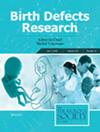Externally attached supra-numerary body structures are a rare congenital malformation. Dysmorphogenesis remains controversial, hence many different classifications have been proposed over the years. We report a case of a supra-numerary lower limb grafted onto a sacrococcygeal mass in a child with a myelomeningocele. Prevailing theories for its origin are revised as well as prenatal and postnatal management.
The case relates to a female neonate with a third lower limb grafted to a lumbosacral mass found upon birth. Postnatal imaging revealed a lipomyelomeningocele and a supra-numerary limb. Surgical intervention was performed on day seven of life with removal of the supra-numerary limb and correction of the dural defect. Anatomopathologic study revealed mature and dysplastic tissues of the three germlines. The infant was discharged after 16 days to follow-up by a multidisciplinary team. In early follow-up, minor asymmetry in lower limb mobility, peri-anal anesthesia, and bladder incontinence was present. Currently 8 years old, the patient has no motor or sensory dysfunction.
This case challenges the existing theories for conjoined twinning, as they do not fully explain the co-occurrence of neural tube defects in sacrally fused supra-numerary structures. Whether these malformations are entities of a single disease spectrum or the result of independent dysmorphogenesis is debated. Prenatal diagnosis with sequential investigation of morphogenesis as well as postnatal anatomopathological examination are crucial for a better understanding of complex biologic processes.


